Sometimes, carmakers create models that practically sell themselves. Toyota has developed a few perennial bestsellers, among them the economical Corolla.
Back in the 2000s, it also produced the Matrix. This tallish four-door hatchback had been part of Toyota’s lineup for about a decade before it was moved to the Scion brand and renamed the iM. Toyota recently discontinued the Scion brand, but it hasn’t done away with all of its models. The iM is now back in the Toyota fold. We now know it as the Corolla iM.
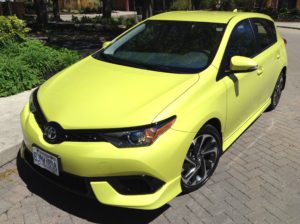
First impressions
As soon as I posted a picture of the Spring Green iM on my social media feeds, one contact blurted: “That’s a Corolla?”
Yes, it is. But you’ll be forgiven for not seeing much resemblance. Toyota may drive the two designs closer over upcoming iterations, but the Japanese automaker won’t yet mess with either vehicle right away.
If you remember the Matrix, you’ll know the iM right away. A lowish hood leads up to a raked windshield. Otherwise, the iM maintains the boxy look of its predecessors, a look that rightfully suggests an economical and roomy hauler.
Toyota has lightly updated the look over the years. A “pointier” nose, side skirts, rear spoiler and “stick-out” taillights offer more definition over the originally rounded body shape. Still, put this 2017 model next to one from ten years ago – as I did on a few occasions – and the similarities stand out far more than any differences.
You might suggest this makes the Matrix – sorry, the iM – boring. You might be right. One person laughed outright at the iM, calling it a “box of matches.” But looks aren’t everything. The fact is, I could easily find many Matrices still on the road, even more than ten years after the specific models were bought. This tells me that owners love these cars. Explore the iM and you’ll see why.
Interior
The iM offers a simple, functional interior. Firm, manually-adjustable heated front seats offer plenty of room to get comfortable
Leather on the shift knob and steering wheel are nice tactile touches. I was mildly disappointed when I saw the shift lever on the floor. The Matrix had the lever farther up the dash, just a few inches away from the steering wheel. This quirky design detail first turned my head when I saw the original Matrix over a decade ago. I suspect it moved to make way for the increasingly obligatory touchscreen.

image courtesy Toyota
The back seats proved roomy enough for me to sit up straight while just touching the ceiling with my head. I’d need somebody shorter than me to sit in front to have enough legroom. Climate control vents help keep rear-seat passengers comfortable.
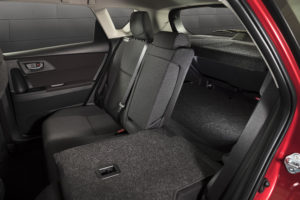
image courtesy Toyota
Hockey bag test
The iM takes one hockey bag with a little more room for things like a laptop bag and a few bags of groceries. The split-folding rear seats offer more room, but I didn’t need to move them.

In-cabin technology
Toyota keeps things simple here, from the 7” touchscreen to the 6-speaker sound system. My tester did not have all bells and whistles (these are available in higher trim levels), so I contented myself with the radio and Bluetooth connection options, forgoing use of the Aha radio subscription option.

image courtesy Toyota
A dial and buttons to the left of the screen work well with the large on-screen icons. My only beef was how the screen becomes illegible if the sun shines on it.
Steering-wheel-mounted controls proved simple enough to use. Controls on the left spoke manage the audio system and phone connections. On the right spoke sit controls for the vehicle information and settings display in the instrument cluster.
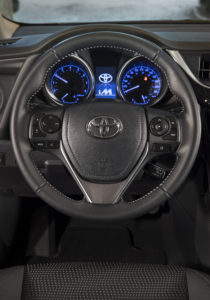
image courtesy Toyota
This 4″ display sits between the tach and the speedo. Letting the driver access audio system settings in this screen would help when direct sunlight makes the touchscreen difficult to read.
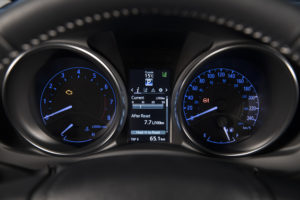
image courtesy Toyota
Cruise control happens via a lever that sticks out diagonally behind the right steering wheel spoke. The layout, while modest, is intuitive enough that most drivers will safely figure it out on the go.
Dual-zone climate controls worked on “up-down” switches and a narrow screen. Again, the setup is easy to learn and simple to use.
Driving
If there’s one knock against the iM, it’s the driving experience. Just about every four-door hatchback I’ve ever driven delivers some thrill, some road feel, a sensation of acceleration, grip around corners. The iM does not lack for control and power where you need it, but most of the time it feels sluggish. Given the fact I drove the 6-speed manual version, that’s saying something. I also couldn’t quite agree with the clutch, given how much travel it offers. But I managed.
Toyota also offers a CVT on the iM. Given the performance of the 137 hp 1.8L 4-cylinder engine and the car’s overall personality, it might be the better choice.
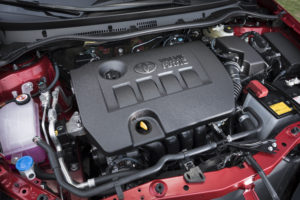
image courtesy Toyota
Toyota packs vehicle stability control, a traction control system and hill-start assist control as standard equipment. Another piece of standard equipment surprised me: a pre-collision avoidance system that applied the brakes as I approached a rising gate arm the iM thought I was about to hit. The iM also features a lane departure alert system. It’s great to see features like this come “downmarket” from higher-end vehicles.
Fuel economy
Here’s where the iM shines. Owners can reasonably expect overall fuel consumption a notch under 7L/100 km. On one highway trip, I managed 6.4.
Conclusions
It won’t be the first choice for performance-biased drivers, but the roominess, practicality and technology in the Corolla iM will continue to earn Toyota fans in the four-door hatchback segment.
Toyota sells the base iM for $22,540 MSRP or $24258.47 after taxes, fees, freight and so forth.